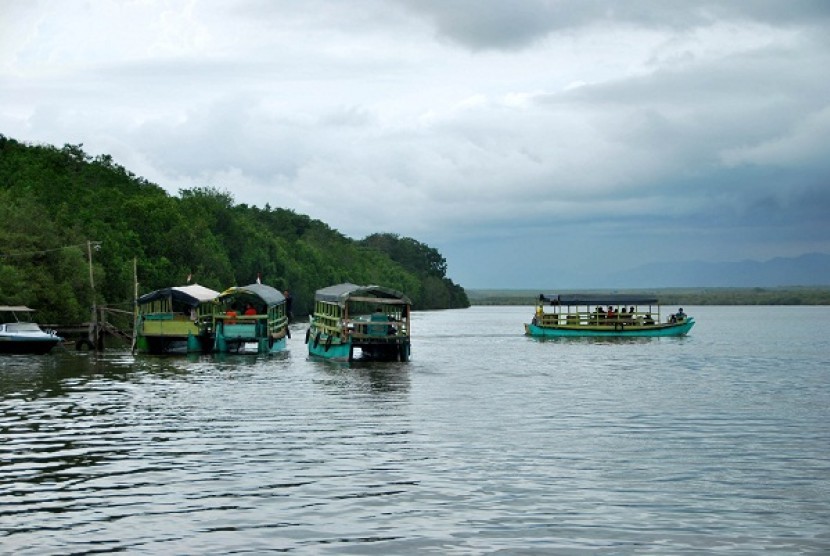REPUBLIKA.CO.ID, By. By Otniel Tamindael
The number of mangrove trees planted along the coast of Indonesian archipelago is expected to reach two billion by 2014.
Planting mangrove trees along Indonesia's sprawling archipelago of more than 17,000 islands with a total coastline of 95,181 kilometers is very important because the country is vulnerable to a rise in sea levels, storm surges and intense tropical storms linked to global warming.
Data from Forestry Ministry indicated that in 2010, people planted 1.3 billion of mangrove trees, and the number continued to increase by 1.5 billion in 2011, 1.6 billion in 2012 and by the end of 2013, it may probably reach 1.8 billion.
"In view of this, we are optimistic that more than two billion mangrove trees will be planted along the coast of the country in 2014," stated Forestry Minister Zulkifli Hasan, recently in Pekalongan district, Central Java.
The minister noted that Indonesia needs to restore two million hectares of mangroves to prevent erosion in the country's coastlines.
While planting mangroves at Angke Kapuk, in North Jakarta early this year, Minister Zulkifli Hasan had pointed out that mangrove rehabilitation and management should be treated as priority.
It is to be noted that mangroves have great importance in the ecosystem as well as in the physical, biological, economic and ecological sectors of the country.
Besides maintaining stability in the coastline, mangroves are also able to protect beaches and cliffs from erosion and abrasion. They also absorb carbon dioxide and pollution as well as waste pollution caused by ships.
"Currently we have only about 3.7 million hectares of mangroves, and we have to restore another two million hectares out of the existing mangrove areas," stated the minister at that time.
According to him, reclamation process has been difficult, because mangrove is not an ordinary plant and the plantation process is not easy.
"The cost is high and the effort needed is also not small, especially if it is used as fishpond, because it would need a lot of mud," he explained.
Zulkifli explained that some of the functions of mangrove trees from an economic standpoint are that mangrove shoots can be processed into animal feed, while the fruit can be used as flour and syrup raw material.
Thus, mangroves can also be beneficial to the welfare of the surrounding community.
"Mangrove's strong roots can even withstand tsunami and strong winds," he added.
The planting of 2,300 seedlings in an area of 99.8 hectares at that time was expected to reduce the rate of erosion and potential flooding in Jakarta's coastal areas, especially during high tides.
Mangroves actually have a lot of benefits but these coastal trees are in a vulnerable state because over the past 20 years, mangrove areas in the country have been reduced by 1.1 million hectares, mainly due to conversion to other land uses.
Therefore, President Susilo Bambang Yudhoyono has called for protection of the 3.7 million hectares of national mangrove forests that helps prevent coastal abrasion and provides a buffer against tsunamis.
During a mangrove-planting event in Tanjung Benoa, Bali, in June, the head of state noted that mangrove forests should be protected.
"We have 130 million hectares of land but the mangroves cover only 3.7 million hectares. Therefore, together let us protect, cultivate, plant, and take care of them to re-green our environment," the president had stated at the time.
Themed Save Mangrove, Save Earth 2013, the mangrove planting event which was attended by environmental activists and Portuguese soccer star Cristiano Ronaldo in Anjung Benoa at that time, was part of an effort to protect mangrove forests along the coasts of Bali Island.
Ronaldo was appointed Care Forum Ambassador of Balinese Mangrove, in March, which means he is the Indonesian Mangrove Ambassador.
"I am happy to be here in Indonesia and I hope that my role in Bali can give more support to mangrove-saving initiatives," stated Ronaldo during the mangrove planting event.
The event was initiated by Bali Mangrove Care Forum where all environmental activists, especially mangrove activists, could align their vision as well as planning and manifesting mangrove protection, conservation and utilization.
According to a number of researches, the mangrove forest is capable of capturing carbon footprint up to five times more than land forests.
Even though the Indonesian mangrove forest is only approximately two percent of the entire country's forests, it certainly can store up to 10 percent of the carbon footprint.
Therefore, the existence of the mangrove forest supports 26 percent reduction of the greenhouse gas emissions and 41 percent emission reduction with the international collaboration in 2020.
Internationally, Indonesia is also known as one of the leading countries in the world's climate change issues, and has taken serious steps to find solutions to climate change problems through various means.
Forestry plays an important role in the national development program through a sustainable management of forest policy, directed toward environmental protection, social and cultural preservation and economic development.



